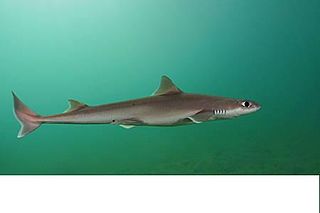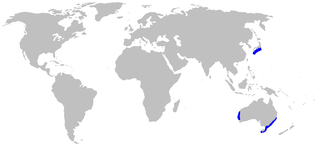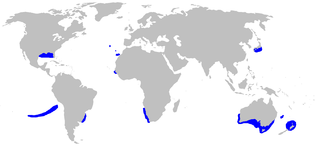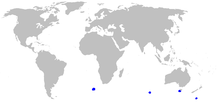
The spiny dogfish, spurdog, mud shark, or piked dogfish is one of the best known species of the Squalidae (dogfish) family of sharks, which is part of the Squaliformes order. While these common names may apply to several species, Squalus acanthias is distinguished by having two spines and lacks an anal fin. It is found mostly in shallow waters and further offshore in most parts of the world, especially in temperate waters. Spiny dogfish in the northern Pacific Ocean have recently been reevaluated and found to constitute a separate species, now known as "Pacific spiny dogfish", Squalus suckleyi.

The school shark is a houndshark of the family Triakidae, and the only member of the genus Galeorhinus. Common names also include tope shark, snapper shark, and soupfin shark. It is found worldwide in temperate seas at depths down to about 800 m (2,600 ft). It can grow to nearly 2 m long. It feeds both in midwater and near the seabed, and its reproduction is ovoviviparous. This shark is caught in fisheries for its flesh, its fins, and its liver, which has a very high vitamin A content. The IUCN has classified this species as critically endangered in its Red List of Threatened Species.

The dumb gulper shark is a rare and endangered deepwater dogfish, known from only along the east coast of Australia and isolated spots north and west of New Zealand. It is also known as the dumb shark, Harrison's deep-sea dogfish, or Harrison's dogfish.

The leafscale gulper shark is a dogfish of the family Centrophoridae. C. squamosus is reported to have a lifespan of approximately 70 years, based on otolith ring counts. It was the first described species in the genus Centrophorus, which now contains 13 species.

The birdbeak dogfish is a dogfish shark of the family Centrophoridae found in the Pacific Ocean around Honshū, Japan, southern Australia, New Zealand, and Chile, and in the Atlantic Ocean from Iceland south to the Cape of Good Hope.

The rough longnose shark is a little-known deepwater dogfish. This species was described by Samuel Garman in 1906 and originally named Acanthidium hystricosa.

The longsnout dogfish is a little-known deepwater dogfish, found in the Atlantic and Indian Oceans from Namibia to Mozambique and in the South Pacific off southern Australia and New Zealand.

The bareskin dogfish is a little-known, deepwater dogfish shark of the family Etmopteridae. This species is found in the western Pacific from southern Japan to western and southeastern Australia as well as in New Zealand waters.

The kitefin shark or seal shark is a species of squaliform shark in the family Dalatiidae, and the only species in its genus. It is found sporadically around the world, usually close to the sea floor at depths of 200–600 m (660–1,970 ft). With a sizable oil-filled liver to maintain neutral buoyancy, this shark is able to cruise slowly through the water while expending little energy. The kitefin shark, the largest luminous vertebrate on record, has a slender body with a very short, blunt snout, large eyes, and thick lips. Its teeth are highly differentiated between the upper and lower jaws, with the upper teeth small and narrow and the lower teeth large, triangular, and serrated. Its typical length is 1.0–1.4 m (3.3–4.6 ft), though examples as long as 5,9 ft.(180cm) have been encountered.

The roughskin dogfish is a sleeper shark of the family Somniosidae, found around the world on continental shelves in tropical, subtropical and temperate seas, at depths of between 100 and 1,500 m. It reaches a length of 121 cm.

The prickly dogfish is a poorly known species of dogfish shark in the family Oxynotidae, inhabiting temperate Australian and New Zealand waters. Reaching a length of 75 cm (30 in), this brown to gray shark has a very thick body with a prominent "humpback" and extremely rough skin. It is further characterized by two enormous, sail-like dorsal fins placed relatively close together. Both dorsal fins have a spine embedded mostly within the fleshy leading portion of the fin; the first dorsal spine is tilted forward.

The sherwood dogfish or Sherwood's dogfish is a very rare sleeper shark of the family Somniosidae, found only around New Zealand. The only specimen studied was about 80 cm long.

The draughtsboard shark is a species of catshark, and part of the family Scyliorhinidae, so named for its "checkerboard" color pattern of dark blotches. It is endemic to New Zealand, where it is also known as the carpet shark. This shark typically reaches 1 m (3.3 ft) in length and has a thick body with a broad, flattened head and a capacious mouth. Its two dorsal fins are placed far back on the body, with the first much larger than the second.

The Portuguese dogfish or Portuguese shark, is a species of sleeper shark of the family Somniosidae. This globally distributed species has been reported down to a depth of 3,675 m (12,057 ft), making it the deepest-living shark known. It inhabits lower continental slopes and abyssal plains, usually staying near the bottom. Stocky and dark brown in color, the Portuguese dogfish can be distinguished from similar-looking species by the small spines in front of its dorsal fins. Its dermal denticles are also unusual, resembling the scales of a bony fish. This species typically reaches 0.9–1 m (3.0–3.3 ft) in length; sharks in the Mediterranean Sea are much smaller and have distinct depth and food preferences.

The Azores dogfish is a very rare sleeper shark of the family Somniosidae. It is known only from the holotype caught north of the Azores and another caught in 2001.

The smooth lanternshark or slender lanternshark is a species of dogfish shark in the family Etmopteridae, found widely in the Atlantic and Pacific Oceans. It inhabits benthic environments at a depth of 274–1,000 m (899–3,281 ft), and pelagic environments at a depth of 0–708 m (0–2,323 ft). The smooth lanternshark forms a species group with the larger blurred lanternshark, both of which are distinguished from other members of their family by small, irregularly arranged dermal denticles with a truncated shape. This species has a slender, dark brown body with an indistinct black band on the sides over the pelvic fins, and reaches 50 cm (20 in) in length. This slow-growing, ovoviviparous shark feeds on smaller squid, fishes, and fish eggs. Smooth lanternsharks are often caught as bycatch in eastern Atlantic and Japanese commercial fisheries. The International Union for Conservation of Nature (IUCN) has evaluated this species as of Least Concern because of its wide distribution and limited threats.

The brown lanternshark or bristled lanternshark is a little-known species of deep-sea dogfish shark in the family Etmopteridae. It is found off Japan and New Zealand, and possibly also South Africa and Australia, typically deeper than 300 m (980 ft). This species can be distinguished from other lanternsharks by its coloration, which is a uniform dark gray or brown without the ventral surface being much darker and clearly delineated from the rest of the body. The brown lanternshark feeds on small bony fishes, cephalopods, and crustaceans. Reproduction is ovoviviparous, with females giving birth to 9–18 young. An unusually high proportion of individuals in Suruga Bay are hermaphrodites, with both male and female characteristics.

The southern sleeper shark or Whitley's sleeper shark is a deepwater benthopelagic sleeper shark of the family Somniosidae found in the southern Atlantic, Indian, and Pacific Oceans. It is known from depths of 400 to 1,100 m. Its length is up to 4.4 m (14 ft). It feeds primarily on cephalopods, especially squid and fish; its stomach contents also less commonly contain remains of marine mammals and birds. Based on its generally sluggish nature and the speed of its prey, it is thought to be an ambush predator. A 3.6 m (12 ft) long female caught off the coast of Chile had a whole southern right whale dolphin in its stomach. This dogfish is sometimes taken as bycatch in the orange roughy and Patagonian toothfish fisheries; whether this poses a threat to the species is currently unknown.

The southern Mandarin dogfish is a species of Mandarin dogfish shark in the genus Cirrhigaleus. It was distinguished from Cirrhigaleus barbifer, which lives in the North Pacific, on an expedition in the coral reefs near Australia in 2007. It is now known to live in the temperate waters in south-eastern Australia and from the Bay of Plenty region in New Zealand, at depths of 146–640 metres.
The northern spiny dogfish, also known as the brown dogfish, grey spiny dogfish or Griffin's dogfish, is a marine species of the family Squalidae, found off New Zealand's North Island. The length of the longest specimen measured is 89.9 cm (35.4 in).




















